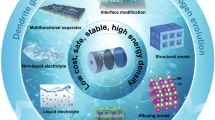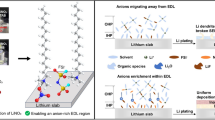Abstract
The discharge characteristics of a heat activated battery containing NiCl2–CoCl2 mixtures as a positive electrode are studied. The battery cell discharge temperature is found to decrease when the mixtures are used instead of individual nickel(II) and cobalt(II) chlorides. The minimum temperature at which a stable discharge plateau is detected is 480°C. The maximum capacity of the discharge plateau is 0.33 A h g–1. The optimum composition of the cathode mixture contains 20 wt % CoCl2. The composition and morphology of the reduction products of the cathodic materials are determined. The initial nickel and cobalt chlorides are reduced to metals during battery cell discharge. The reduction process is accompanied by the diffusion of lithium halides from the separator to the cathodic space. The reduced metals (Ni, Co) form a network of branched dendrites covered with a salt film based on lithium chloride. The density and morphology of the dendritic deposit is determined by the composition of the initial cathodic mixture. The salt film consists of solid solutions and peritectics of the Li, Co, Ni||Cl, Br, F system. The reduction of M2+ (where M = Ni, Co) to the M0 metal is shown to proceed via a melt mechanism in the diffusion kinetics mode.








Similar content being viewed by others
REFERENCES
R. A. Guidotti and P. Masset, J. Power Sources 161, 1443–1449 (2006). https://doi.org/10.1016/j.jpowsour.2006.06.013
R. Guidotti, F. W. Reinhardt, J. Dai, and D. E. Reisner, J. Power Sources 160, 1456–1464 (2006). https://doi.org/10.1016/jjpowsour.2006.02.025
P. A. Nelson, J. Power Sources 29, 565–577 (1990). https://doi.org/10.1016/0378-7753(90)85026-9
P. J. Masset and R. A. Guidotti, J. Power Sources 177, 595–609 (2008). https://doi.org/10.1016/j.jpowsour.2007.11.017
P. J. Masset and R. A. Guidotti, J. Power Sources 178, 456–466 (2008). https://doi.org/10.1016/j.jpowsour.2007.11.073
P. Butler, C. Wagner, R. Guidotti, and I. Francis, J. Power Sources 136, 240–245 (2004). https://doi.org/10.1016/jjpowsour.2004.03.034
M. Au, J. Power Sources 115, 360–366 (2003). https://doi.org./10.1016/S0378-7753(02)00627-4.
P. J. Masset, Z. Naturforsch. 63a, 596–602 (2008). https://doi.org/10.1515/zna-2008-0911
O. V. Volkova, V. V. Zakharov, and O. G. Reznitskikh, “Electroreduction of chromium(III) chloride in a thermal battery,” Russ. Metall. (Metally), No. 8, 655–659 (2017).
O. V. Volkova and V. V. Zakharov, “Electroreduction of chromium(III) chloride and molybdenum(VI) oxide mixtures in a thermally activated battery,” Russ. Metall. (Metally), No. 2, 201–204 (2018).
S. A. Barnashov, A. I. Eliseev, N. M. Shchetkin, V. A. Zagainov, I. V. Koroleva, E. V. Radetskaya, A. I. Bondarenko, et al., “Thermal battery,” RF Patent 2369944, 2007.
O. V. Volkova, V. V. Zakharov, E. G. Vovkotrub, S. V. Plaksin, and S. V. Pershina, “Electroreduction of mixtures of nickel(II) chloride and molybdenum(VI) oxide in a thermally activated battery,” Rasplavy, No. 5, 411–422 (2019).
V. V. Zakharov et al., “Method of manufacturing lithium–boron composite and reactor,” RF Patent 2395603, 2010.
H.-J. Seifert, Z. Anorg. Allg. Chem. 307, 137–144 (1961). https://doi.org/10.1002/zaac.19613070305
M. S. Golubeva and B. S. Medvedev, “Ternary reciprocal system of lithium and nickel chlorides and sulfates,” Zh. Neorg. Khim. 7 (2), 2600–2603 (1962).
M. V. Smirnov, Electrode Potentials in Molten Chlorides (Nauka, Moscow, 1973).
A. A. Elshin, “Electrochemical behavior of cathodes of high-temperature batteries based on transition metal chlorides,” Candidate’s Dissertation in Chemistry (Sverdlovsk, 1990).
ACKNOWLEDGMENTS
The studies were carried out using the equipment of the Shared Access Center Composition of Compounds at High-Temperature Electrochemistry Institute, Ural Branch, Russian Academy of Sciences.
Author information
Authors and Affiliations
Corresponding author
Additional information
Translated by E. Yablonskaya
Rights and permissions
About this article
Cite this article
Volkova, O.V., Zakharov, V.V., Il’ina, E.A. et al. Electroreduction of Nickel(II) Chloride and Cobalt(II) Chloride Mixtures in a Heat Activated Battery. Russ. Metall. 2021, 957–963 (2021). https://doi.org/10.1134/S003602952108022X
Received:
Revised:
Accepted:
Published:
Issue Date:
DOI: https://doi.org/10.1134/S003602952108022X




